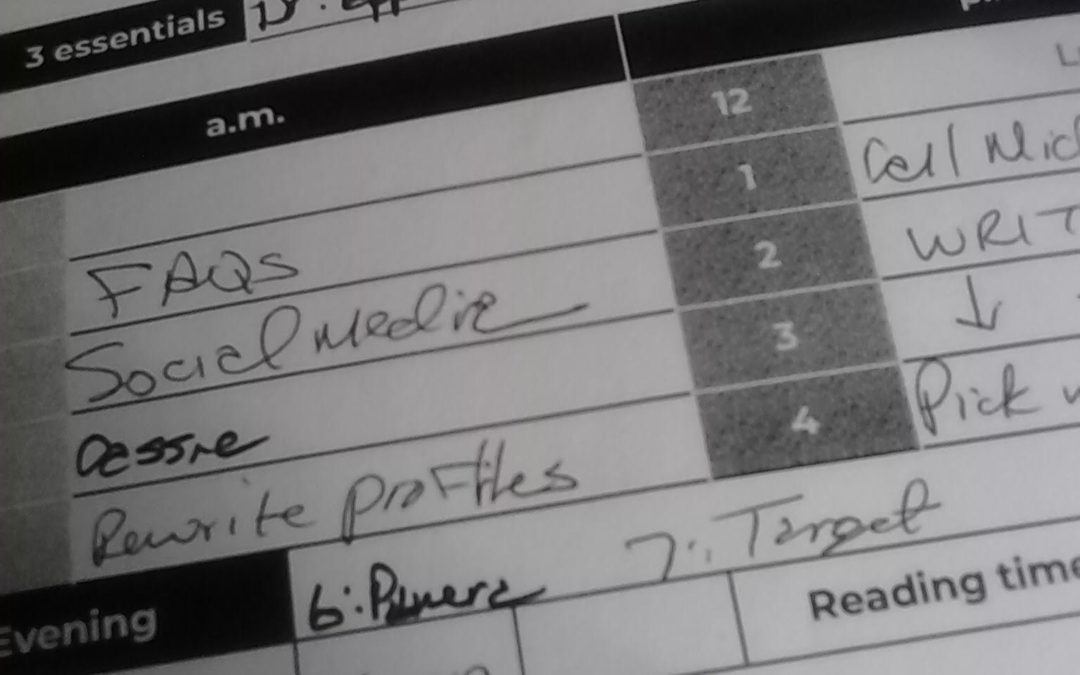There’s a mode we find instinctively comfortable: Neutral.
Unless you’re cashing residual income checks for your contributions to that one Kajagoogoo song, you can’t afford to stay there long. Neutral rocks for three-day weekends and waiting out thunderstorms. It’s a lousy gear to get you much of anywhere, however.
It’s also a terrible way to get anything done, from the must-dos to the wish-i-could-dos to the why-do-I-dos. We all live such fully integrated lives, and when that nasty b word – busy, I mean – hijacks or mindset and conversation, it brings with it a built-in excuse to ignore as we wish.
Busy is often a buzzword for not knowing how to find your rhythm. Rhythm is essential if you want to keep multiple interests in your life afloat! You set a rhythm for your life through trial and error, experimenting with methods and practices and finding those that just stick.
I’m far from a master, but I don’t spend a lot of time in neutral. This is what has helped me.
My titles
I have three arenas where most of my activity takes place:
SOCCER FIELD | I’m a coach. It’s my job to train my teams for games (and life!).
HOME | I have a family to take care of, from keeping Netflix current to making tacos.
WORK | I write web content, including a sometimes sorely neglected blog, and three books.
If I pour all my energy into coaching, we might win a soccer title. But my tropical fish will die and my boss won’t be too happy.
If I go 100% as dad and provider, that’s awesome. My players might lose interest in training, though, and … well, my boss still isn’t thrilled.
Guess what happens if I turn to full workaholic mode? (Not even my boss would like that.) These are the three practices in place that help.
My rhythms
1. Set Intentions
I use notecards, divided in a dollar-store card box. Each section had tasks related to that portion of my life: Create offseason workout plan … find pizza places for all road games … install hardwood flooring … write that guest post for Jenn …
Each card has an action plan list. There’s always a first step. These first steps find their way onto my to-do lists. Everything I want or need to do is on a notecard. All notecards are divided into categories: Home, work, soccer and other things.
(This practice will free up precious room on the most important hard drive of your life – your brain! When I get a new idea, it goes on a notecard. No more brain storage.)
2. Take action
I use this grid for every day. It includes calendar items (that I store on my Google calendar) and transfer to this hard copy. It’s my itinerary for the day. I purposely didn’t include smaller than hour increments – because I’d double book them!
Each day also includes reminders for key elements such as journal, meditation, exercise and blog time. It also includes spots for three daily essentials.
These are the hot button actions – make a doctor’s appointment, find your soccer cones, etc. It’s also where I reserve one spot always for that other things list.
3. Reassess
Every month, I rearrange (and clean) my work space. Otherwise, it wouldn’t get done. It gives me a fresh perspective, and also clues me to clean up my rhythm too. It’s time to ask what worked? What didn’t? What got better? What got neglected?
I love this time. Instead of rueing categories for hurting others, I get to choose what to prioritize. Garage look like a pawn shop gone wrong? Latest blog post came in the Taft administration? My training sessions getting a little yawnful? Here’s my chance to fix that.
This step is especially critical during that 17 minutes between soccer seasons (actually a month or two!) to shore up other parts of my life (and get some color back in my face with better nutrition and closer-to-adequate sleep!)
My rhythm-making might not work perfectly for you, but it helps me to keep a hand on all that is important in my life. And you can adjust it to fit your life any way that works.
Focus on being present and being productive, whether that’s on Taco Night or Tournament Time. Life has so many delicious chapters – and we can keep a hand in them all.
BE:
Mindful – appreciate what you’re doing in the moment and don’t worry about the rest
Grindful – this is work. Do the things you need to do even when you don’t feel like doing them
Remindful – not just what works and doesn’t, but of the beauty in why you do it in the first place.
# # #
When he isn’t on the sideline, on a soap box, or hosting wonderful guest bloggers, Eli Pacheco writes a blog called Coach Daddy. Connect with him on Google Plus, Instagram, Pinterest and Twitter.

